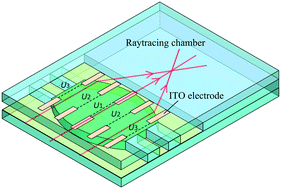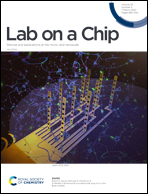Aberration-free aspherical in-plane tunable liquid lenses by regulating local curvatures†
Abstract
Aberration is a long-standing problem of fixed focal lenses and a complicated lens set is usually required to compensate for aberration. It becomes more challenging for tunable lenses. This paper reports an original design of an in-plane optofluidic lens that enables compensation for spherical aberration during the tuning of focal length. The key idea is to use two arrays of electrode strips to symmetrically control the two air/liquid interfaces by the dielectrophoretic effect. The strips work together to define the global shape of the lens interface and thus the focal length, whereas each strip regulates the local curvature of the interface to focus the paraxial and peripheral arrays on the same point. Experiments using a silicone oil droplet demonstrate the tuning of focal length over 500–1400 μm and obtain a longitudinal spherical aberration (LSA) of ∼3.5 μm, which is only 1/24 of the LSA (85 μm) of the spherical lens. Fine adjustment of the applied voltages of strips allows even elimination of the LSA and enabling of the aberration-free tunable lenses. It is the first time that local curvature regulation is used to compensate for the aberration within one in-plane liquid lens. This simple and effective method will find potential applications in lab-on-a-chip systems.



 Please wait while we load your content...
Please wait while we load your content...